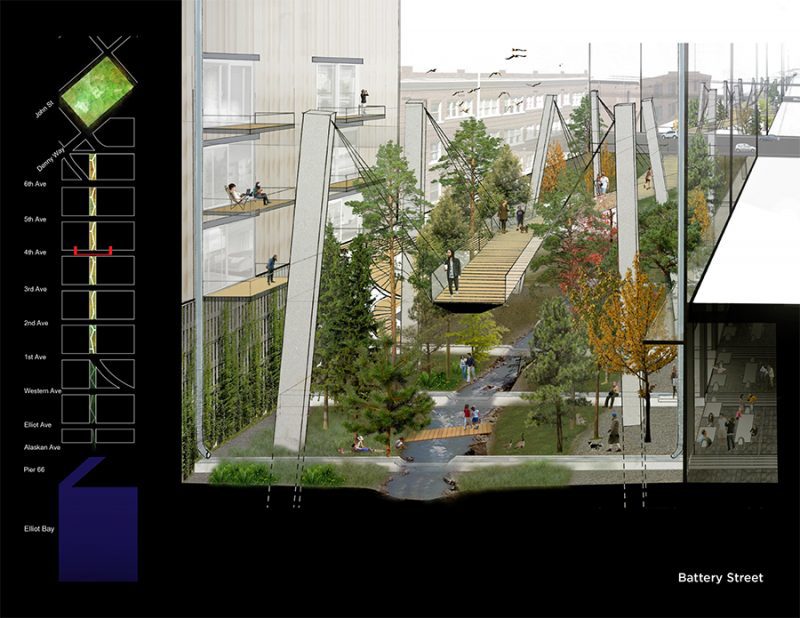Miller Hull
- Portfolio
- Approach
- News
Events
2024 West Region Conference – Cultural Crossroads in Education: Ruth Baleiko
Posted March 26, 2024
- About
- Connect
The Miller Hull Partnership proposes turning a defunct Seattle tunnel into a landscaped canyon
Source: Metropolis Magazine
8-10-2018 | News
by David Cole

During the 20th century, it wasn’t uncommon for prominent architects to put forth bold visions for the future of cities. Frank Lloyd Wright presented his initial ideas for Broadacre City in 1932 and continued refining them until his death in 1959. During the postwar era, Buckminster Fuller proposed enclosing part of Manhattan under a geodesic dome, and Paul Rudolph famously proposed a Brutalist megastructure over the Lower Manhattan Expressway, still a glimmer in Robert Moses’s eye at that time.
Perhaps chastened by the reactions to such grandiose schemes, the architecture profession from the 1980s onward took a more conservative tack, generally preferring to pour its most ambitious efforts into corporate projects. At the same time, the automobile-oriented orthodoxy of postwar American urban planning began to be seriously questioned. Infrastructure that seemed visionary in the 1950s is now considered archaic and anti-urban.
In Seattle, the Alaskan Way Viaduct—built as part of a postwar expressway project that sliced the waterfront off from the rest of downtown in a manner that Robert Moses himself might have conjured up—is rapidly approaching the end of its life as a conduit for automobiles. The fate of one viaduct segment has been especially debated: The Battery Street Tunnel, which travels underneath six blocks of downtown Seattle.
Related Articles
Democracy and Maya architecture inform Miller Hull’s US embassy in Guatemala City
By Jenna McKnight Design studio The Miller Hull Partnership has drawn upon Maya architecture and the "openness and…
7-13-2023 | News
Idaho school master plan takes on Living Building Challenge
By John MacKay and Chris Hellstern For any educational institution, embarking on a master plan journey…
8-27-2020 | News
The Registry Q&A: Miller Hull Launches New Sustainability Initiative, EMission Zero
The Registry By Catherine Sweeney Miller Hull Partnership is continuing to expand its sustainability efforts, recently launching…
2-17-2022 | News
Collaboration and care drive design of new UW health sciences building
Last October, after 39 months of construction, the University of Washington opened a new 97,000-square-foot Health…
8-23-2023 | News
US Breaks Ground on New $300 Million Consulate General in Casablanca
By Morgan Hekking Rabat – The US diplomatic mission in Casablanca laid the first stone of its new consulate…
12-3-2020 | News
Miller Hull stage sponsor for ‘March for Science’ Seattle
We're sponsoring the 'March for Science' in Seattle on Earth Day, Saturday, April 22nd. The March…
4-21-2017 | Events
××